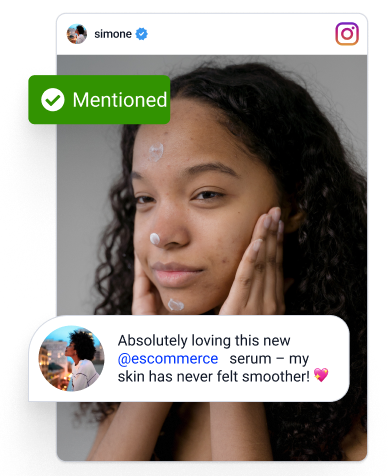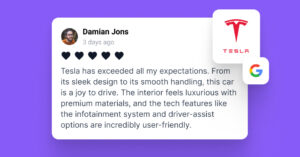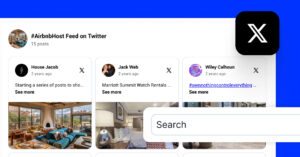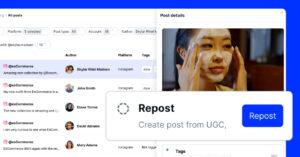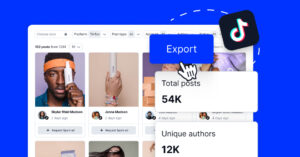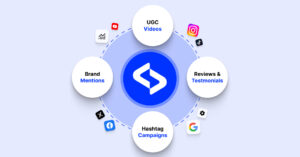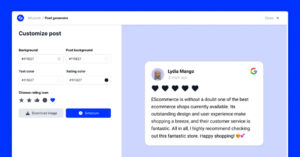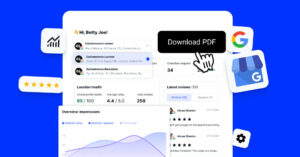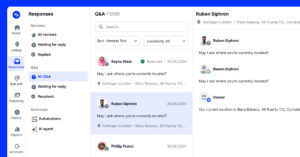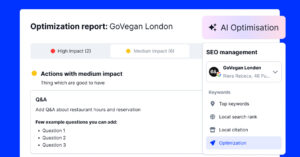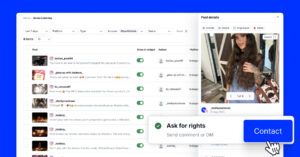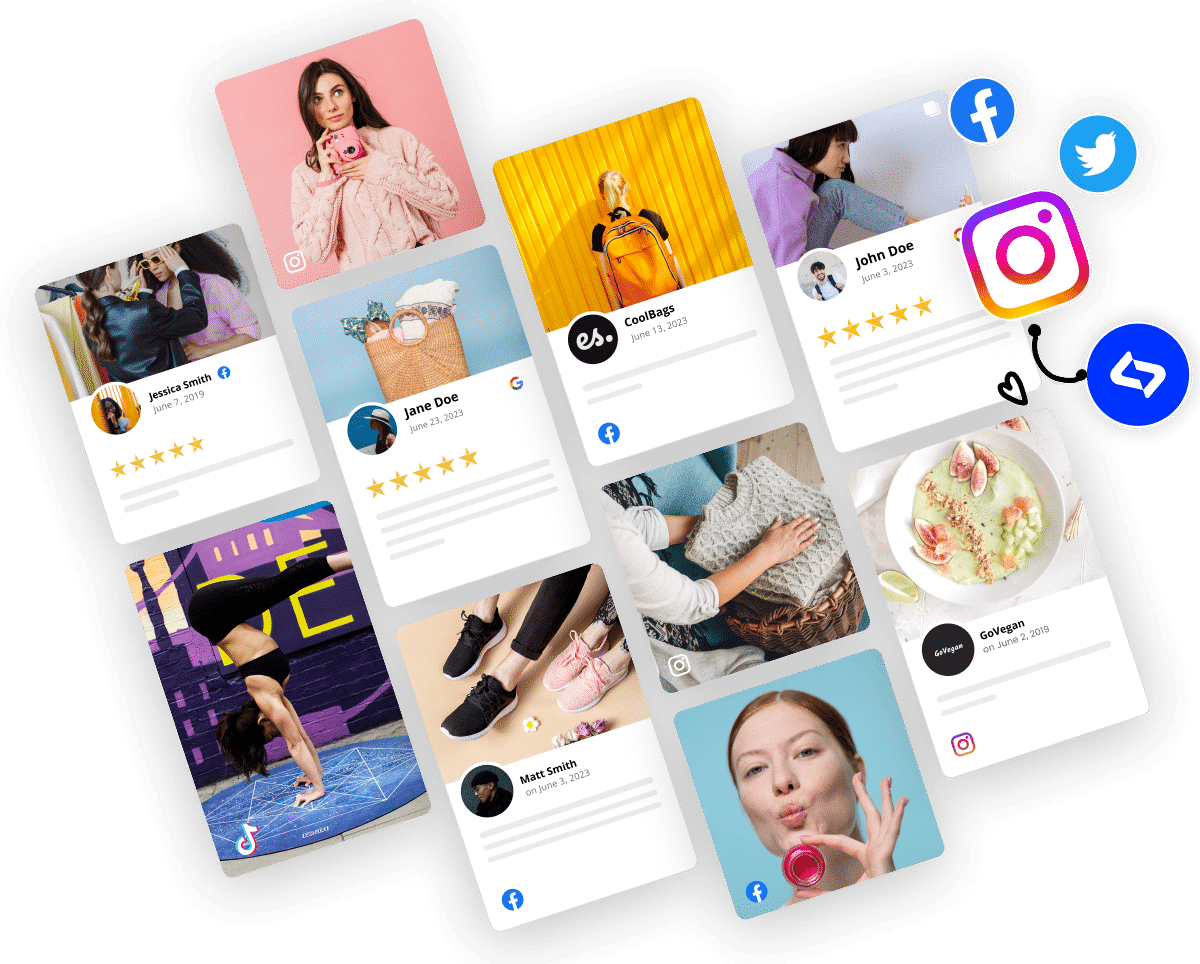Avez-vous déjà eu l'impression de passer à côté de ce que les gens disent vraiment de votre marque en ligne ?
C'est là que écoute sociale Les indicateurs de performance entrent en jeu. Il ne s'agit pas de simples chiffres de vanité : ils révèlent le ton, la portée et l'influence de chaque mention en ligne qui compte.
Qu'il s'agisse de suivre le lancement d'un produit, de surveiller une crise ou simplement de garder une longueur d'avance sur vos concurrents, il est essentiel de savoir ce qu'il faut mesurer.
Décortiquons les indicateurs les plus importants que vous devez suivre et comment ils vous aident à transformer les conversations en stratégie.
Pourquoi suivre les mesures d'écoute en 2025 ?
Tout d'abord, vous vous demandez peut-être ce que sont les mesures d'écoute sociale.
Eh bien, ils le sont des points de données qui vous aident à suivre et à analyser les conversations en ligne sur votre marque, y compris les mentions, le sentiment, la portée et les tendances.
Le suivi des bonnes mesures d'écoute des médias sociaux vous donne un avantage concurrentiel :
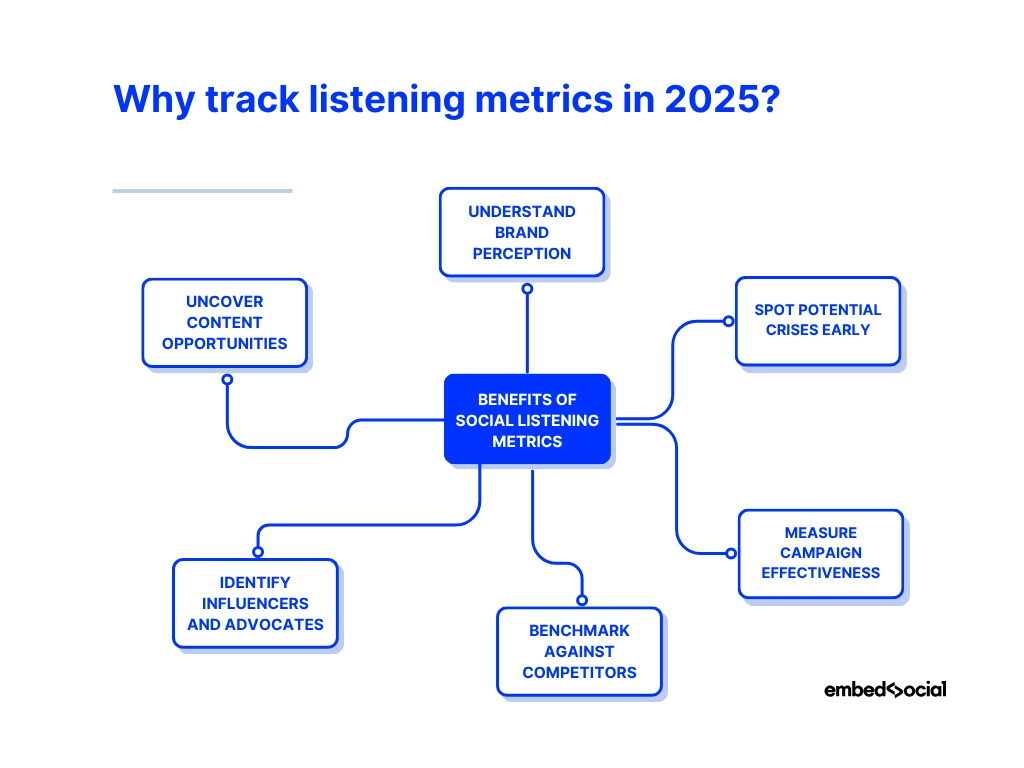
- Comprendre la perception de la marquevoir ce que votre public pense vraiment de votre entreprise ;
- Repérer rapidement les crises potentiellesdétecter les baisses de sentiment ou les pics dans les mentions avant qu'ils ne s'aggravent ;
- Mesurer l'efficacité de la campagnesuivre en temps réel la façon dont les gens réagissent à votre marketing ;
- Comparaison avec les concurrentscomparer votre part de voix dans l'ensemble du secteur ;
- Identifier les personnes influentes et les défenseurs des droits de l'hommetrouver les voix qui façonnent la réputation de votre marque ;
- Découvrir des opportunités de contenu -exploitent les sujets en vogue et les points de douleur des clients pour un meilleur engagement.
Il s'agit là de toutes les mesures que vous devez suivre pour obtenir les informations nécessaires à l'élaboration de stratégies plus intelligentes et à l'obtention de meilleurs résultats pour votre marque aujourd'hui.
7 mesures de base de l'écoute des médias sociaux à suivre immédiatement
EmbedSocial fournit un ensemble complet de mesures d'écoute qui vous aident à transformer les mentions brutes en informations en temps réel. Voici ce que vous pouvez suivre immédiatement - aucune configuration n'est nécessaire :
| Métrique | Pourquoi c'est important | Pris en charge dans EmbedSocial |
|---|---|---|
| 📈 Volume des mentions | Suivi de la fréquence à laquelle votre marque est mentionnée sur les différentes plates-formes | ✅ |
| 😊 Analyse des sentiments | Comprend comment les gens se sentent - positifs, neutres ou négatifs | ✅ |
| 🧑 Principaux influenceurs | Identifie les voix clés qui animent les conversations | ✅ |
| 🔥 Sujets d'actualité | Révèle quels hashtags ou thèmes dominent vos mentions | ✅ |
| 🖼️ Ventilation du contenu | Indique les types de contenu et les plates-formes les plus performants | ✅ |
| 🥇 Partage de la voix (SOV) | Comparaison de votre visibilité avec celle de vos concurrents | ✅ |
| 📊 Afficher les tendances de la chronologie | Associe les pics d'activité à des événements, des campagnes ou des mentions. | ✅ |
1. Volume des mentions
Cette mesure indique la fréquence à laquelle votre marque ou votre campagne est mentionnée sur les canaux sociaux.
À l'intérieur d'EmbedSocial, vous verrez nombre total de messages, nouvelles mentions par semaine, et tendances de l'activité quotidienne-le tout visualisé dans un tableau chronologique clair :
Mini-cas d'exemple : Lorsqu'une marque fictive, "GlowRush Skincare", a lancé sa ligne de printemps, elle a remarqué un pic de volume le 14 avril. En utilisant le tableau chronologique des posts d'EmbedSocial, ils sont remontés jusqu'à une bobine d'influenceur non étiquetée qui est devenue virale, ce qui les a aidés à reproduire le format de contenu pour les lancements futurs.
Conseil de pro : Utilisez les pics de volume pour déterminer quand une campagne, un hashtag ou un partenariat avec un influenceur a généré un buzz inattendu.
2. Analyse des sentiments
Cette mesure vous aide à comprendre ce que les gens pensent de votre marque.positive, négative ou neutre.
Avec EmbedSocial, chaque ensemble de données comprend automatiquement un répartition des sentimentsVous pouvez ainsi suivre l'évolution de l'état d'esprit de la marque dans le temps ou identifier les changements survenus après les campagnes :
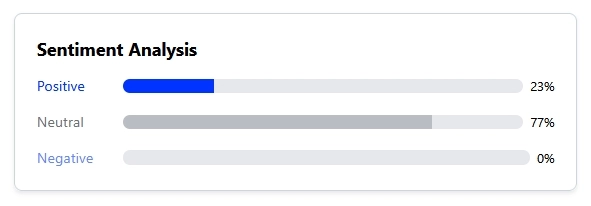
Mini-cas d'exemple : Lorsque la société "BoltBites Energy Bars" a diffusé une publicité controversée, elle a constaté un pic soudain de sentiments négatifs. En isolant cette semaine dans l'outil de suivi des sentiments d'EmbedSocial, ils ont retravaillé leur message et ont vu les sentiments redevenir positifs deux semaines plus tard.
Conseil de pro : Suivez l'évolution du sentiment chaque semaine pour détecter les premiers signes d'un problème de relations publiques ou pour valider le succès d'une campagne en temps réel.
3. Principaux influenceurs et sources
Cette mesure permet de savoir qui alimente les conversations les plus percutantes sur votre marque.
EmbedSocial met en évidence les les auteurs et créateurs de contenu les plus actifs sur l'ensemble des plateformes, ce qui vous permet de filtrer par nombre de messages et par source pour obtenir des informations plus approfondies :
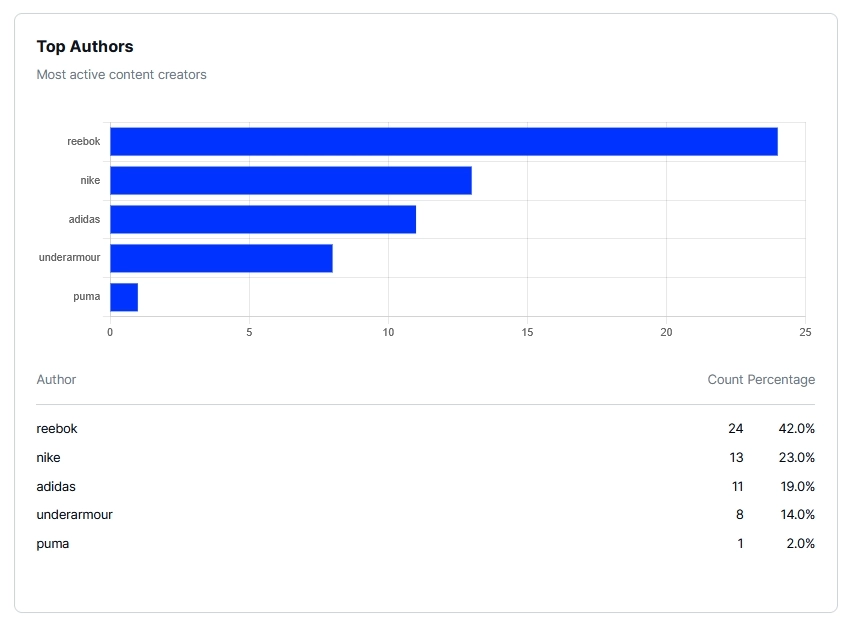
Mini-cas d'exemple : "TrailShift Apparel" a découvert qu'une photographe de niche spécialisée dans les activités de plein air avait publié trois articles sur son matériel en une semaine. En la repérant dans le classement des meilleurs auteurs, ils se sont associés à elle pour offrir un cadeau, doublant ainsi l'engagement lors de leur prochain lancement.
Conseil de pro : Trouvez les auteurs les plus prolifiques par volume pour découvrir des partenariats d'influenceurs dont vous ignoriez l'existence.
4. Sujets d'actualité et hashtags
Cette mesure montre les mots et les hashtags les plus utilisés dans les mentions de votre marque.
EmbedSocial visualise les hashtags populaires et les mots-clés les plus utilisés comme les diagrammes à barres et les nuages de tags, vous aidant ainsi à rester au fait des tendances :
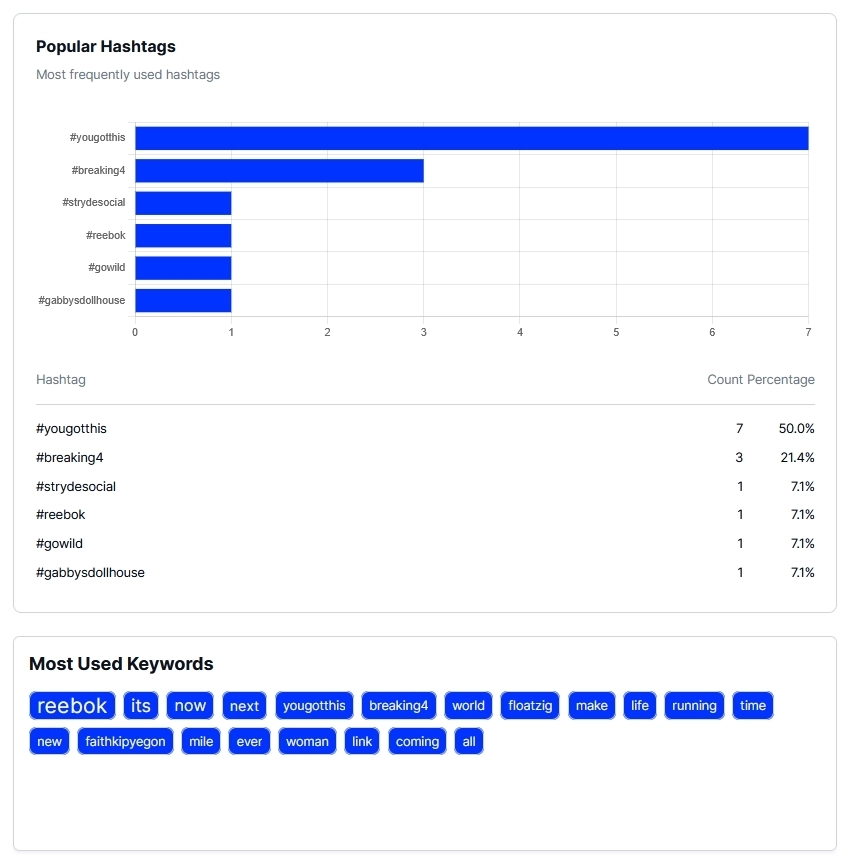
Mini-cas d'exemple : "Pawfect Treats", une marque fictive de snacks pour animaux, a repéré le tag #dogsoftiktok en hausse dans ses mentions. Ils ont créé une série de contenu autour de la tendance et ont doublé leurs gains Instagram en 3 jours.
Conseil de pro : Surveillez les hashtags toutes les semaines - en sautant sur une tendance pertinente, vous pouvez augmenter votre portée sans dépenser de publicité.
5. Répartition du contenu
Cette mesure vous indique quel type de contenu est le plus courant - images, vidéos, carrousels - et sur quelles plateformes il est publié.
EmbedSocial divise les données par le type de contenu et la plate-forme afin que vous puissiez voir rapidement où se déroulent les conversations et dans quel format :
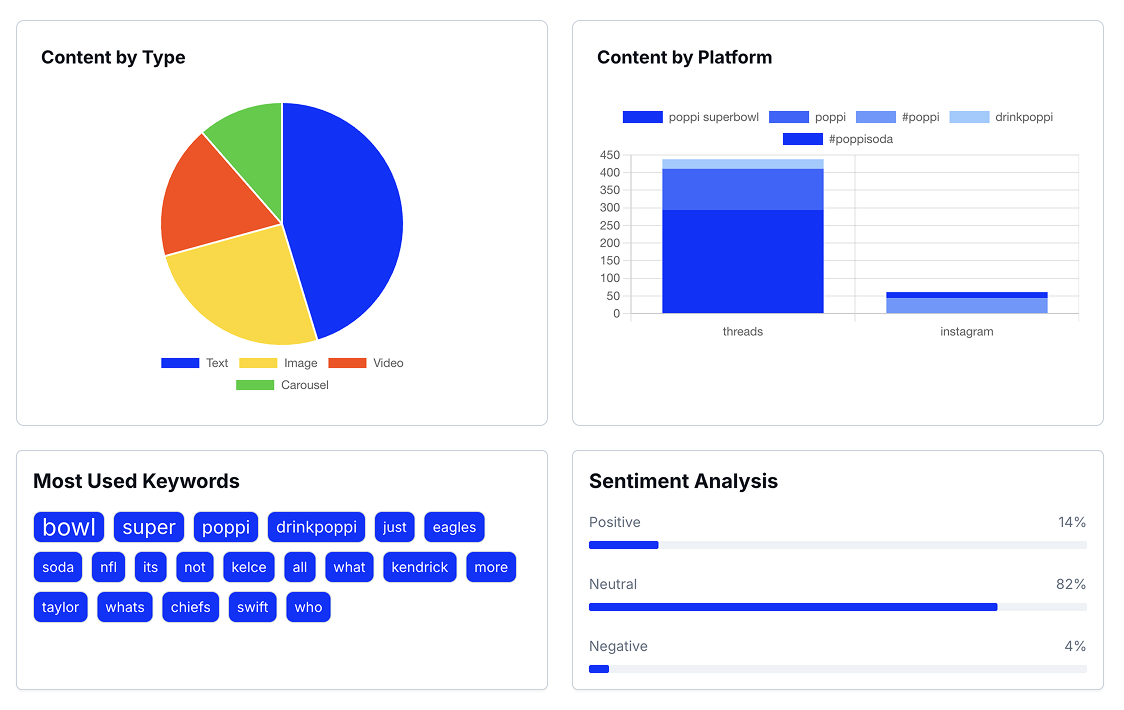
Mini-cas d'exemple : "FitVerse Gear" s'est rendu compte que ses posts carrousel n'étaient pas assez performants. Le tableau de contenu d'EmbedSocial a montré que les vidéos généraient 70% de posts en plus - ils ont donc réorienté leur budget vers les carrousels et doublé les conversions.
Conseil de pro : Utilisez les données relatives au type de contenu pour orienter votre stratégie de marketing créatif - tous les formats n'ont pas les mêmes performances d'une plateforme à l'autre.
6. Part de voix (SOV)
Cet indicateur compare la visibilité de votre marque à celle de vos concurrents sur les plateformes sociales.
EmbedSocial propose un service autonome de La part de voix calculatrice qui permet de visualiser part de marchéLes données sur les hashtags et les mentions permettent d'obtenir des informations sur la qualité de l'information, le sentiment, les principaux mots-clés et bien plus encore :
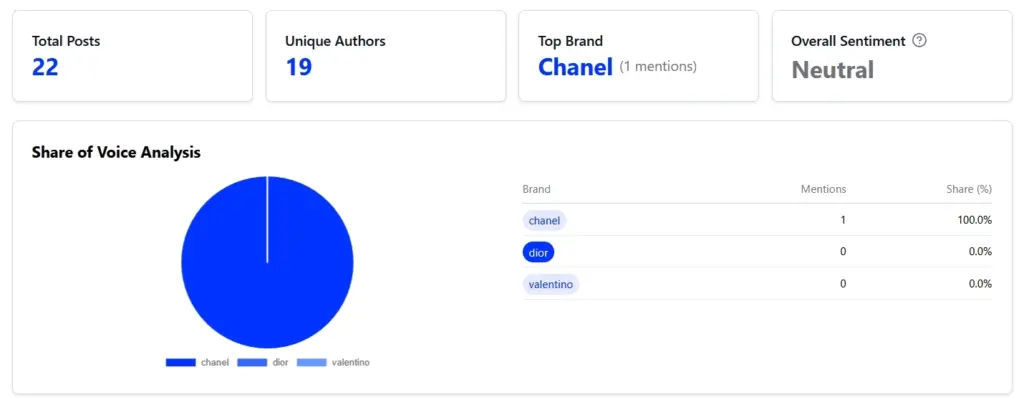
Mini-cas d'exemple : "Lumo Sneakers" a utilisé le calculateur SOV pour comparer sa visibilité à celle d'Adidas et de Puma pendant la semaine de lancement. Ils ont constaté qu'ils détenaient 32% de parts et ont utilisé cette information dans leur présentation à l'investisseur.
Conseil de pro : Suivez l'évolution de la consommation avant et après les grands lancements pour mesurer la pénétration de votre campagne sur le marché.
7. Tendances de la chronologie de l'affichage
Cette mesure montre comment les mentions de la marque fluctuent dans le temps - quotidiennement ou hebdomadairement.
EmbedSocial affiche toutes les mentions dans une rubrique format de la ligne de tendanceIl est donc facile d'identifier les poussées de campagne, l'impact des influenceurs ou les pics de relations publiques :
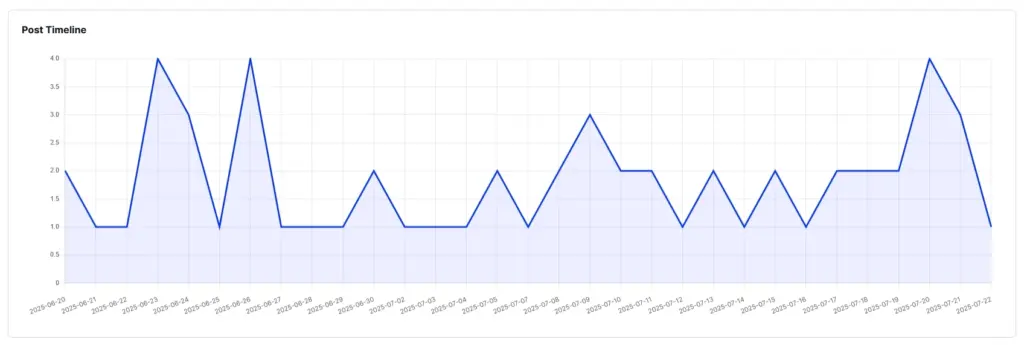
Mini-cas d'exemple : "BriteBox LED" a organisé un concours le 1er juillet. Leur chronologie dans EmbedSocial a montré une forte augmentation du nombre de messages pendant trois jours, puis une baisse. Ils ont réengagé les participants via les Stories et ont maintenu l'intérêt pendant une semaine.
Conseil de pro : Annotez les pics avec des noms de campagne afin que votre équipe puisse relier les performances à des actions spécifiques.
Pourquoi suivre les mesures d'écoute sociale via EmbedSocial ?
Que vous rassembliez commentaires des clientsQu'il s'agisse de garder un œil sur les concurrents ou d'informer les ventes et les efforts de marketing, le fait de disposer de la bonne information sur l'état de l'environnement est essentiel. outil de suivi social questions. EmbedSocial offre une plateforme puissante et facile à utiliser, conçue exactement pour cela.
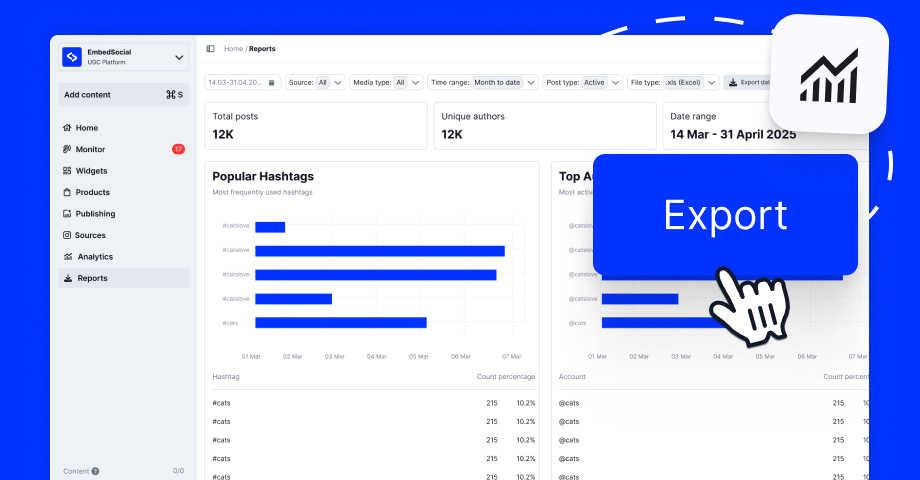
Voici ce qui fait d'EmbedSocial un choix judicieux pour votre marque :
- Contrôler les mots-clés de marque en temps réel - suivre les mentions, les hashtags et les conversations pertinentes sur votre marque, vos produits ou vos concurrents sur les principales plateformes de médias sociaux ;
- Obtenir analyse des sentiments - obtenir des informations précieuses sur ce que les gens pensent de votre entreprise, avec des mentions classées par ton, sujet ou source ;
- Centraliser vos données sur l'ensemble des canaux - tirer contenu généré par l'utilisateur d'Instagram, de TikTok, de Facebook, de Google, de X (Twitter) et d'autres encore dans un seul tableau de bord ;
- Personnaliser les étiquettes et les filtres - regrouper et étiqueter les conversations en fonction des campagnes, des départements ou des thèmes pour rationaliser la collaboration ;
- Recherche et filtrage des mentions historiques - faire remonter rapidement des commentaires pertinents à l'aide de filtres tels que le mot-clé, la date, le type de contenu et la plateforme ;
- Laisser l'IA faire le gros du travail - tirer parti de résumés intelligents et de la détection des tendances pour vous permettre de repérer ce qui est important, sans vous noyer dans les données ;
- Informer les équipes sans effort - générer des rapports faciles à partager ou mettre en place des alertes automatisées pour que tout le monde soit sur la même longueur d'onde.
En bref, si vous recherchez un moyen simple et évolutif d'écouter, de suivre et d'agir sur ce que dit votre public cible, EmbedSocial est prêt quand vous l'êtes.
Apprendre comment mettre en place un système d'écoute des médias sociaux flux aujourd'hui !
Comment faire de l'écoute sociale correctement : Stratégie en 6 étapes
Pour obtenir une réelle valeur commerciale, il faut une stratégie qui transforme l'écoute en action, et pas seulement un suivi des mesures d'engagement. Voici comment une marque moderne peut mettre en place une telle stratégie à l'aide de EmbedSocial-l'un des meilleurs outils d'écoute des médias sociaux dans le monde :
- Fixer des objectifs et des indicateurs de performance clés alignés sur les objectifs de l'entreprise
- Choisissez vos outils d'écoute des médias sociaux et vos sources de données
- Configurer les thèmes d'écoute, les mots-clés et les filtres
- Collecte et visualisation des données
- Analyser les tendances et extraire des informations exploitables
- Faites part de vos conclusions et agissez
1. Fixer des objectifs et des indicateurs de performance clés alignés sur les objectifs de l'entreprise
Lorsque vous apprenez à mesurer l'écoute sociale, commencez par définir vos objectifs. Cherchez-vous à améliorer la réputation de votre marque ? Suivre l'efficacité d'une campagne ? Surveiller les concurrents ?
Assurez-vous que votre KPI d'écoute sociale-comme le volume des mentions ou les changements de sentiment-se rattachent directement aux objectifs plus larges de l'entreprise.
Café BoldBean a commencé le lancement de son espresso glacé en identifiant des objectifs clés : mesurer l'engouement pour la marque, suivre l'évolution des sentiments et évaluer l'efficacité du hashtag #coldbrewenergy sur les différentes plateformes.
2. Choisissez vos outils d'écoute des médias sociaux et vos sources de données
Choisissez un outil adapté à vos objectifs. Les meilleures plateformes tirent des données des réseaux sociaux, des sites d'information, des blogs et des forums, et non d'un seul canal.
EmbedSocial vous permet de télécharger ou de connecter les données de votre marque à partir d'Instagram, X, et plus encore - ainsi votre écoute commence avec une image complète.
BoldBean a choisi EmbedSocial pour surveiller Instagram et X, mais ils ont également ajouté des blogs de mode et de style de vie à leur mélange de données, s'assurant qu'ils ne manqueraient pas les mentions générées par les utilisateurs des communautés de niche.
3. Configurer les thèmes d'écoute, les mots-clés et les filtres
Il est maintenant temps de peaufiner. Choisissez le nom de votre marque principale, les hashtags de votre campagne, les termes de votre produit ou les noms de vos concurrents.
EmbedSocial vous permet de filtrer par mots-clés, plates-formes et même par type d'auteur pour que votre flux reste ciblé et sans bruit.
Ils ont mis en place un suivi des mots-clés pour "iced espresso", "BoldBean", "#coldbrewenergy" et des expressions concurrentes. Ils ont exclu les termes non pertinents, comme les cafés locaux sans rapport, pour se concentrer uniquement sur les mentions exploitables.
4. Collecte et visualisation des données
Une fois que les mentions commencent à affluer, ne vous laissez pas submerger par le texte brut. Examinez les tendances en matière de volume, la répartition des sentiments, les principaux influenceurs et les groupes de sujets.
Avec EmbedSocial, cela se fait automatiquement. Vous obtenez un tableau de bord visuel qui montre toutes les tendances clés en temps réel.
Au cours des premiers jours, BoldBean a constaté un pic dans le volume de mentions et un changement de sentiment de neutre à positif. Le tableau de bord montrait clairement que l'élan provenait d'une TikTok générée par les utilisateurs et qui ne faisait même pas partie de leur campagne payante.
5. Analyser les tendances et extraire des informations exploitables
Recherchez les pics, les creux ou les thèmes récurrents. Comparez les performances avant et après les lancements ou les activités des concurrents.
EmbedSocial permet de zoomer sur n'importe quel jour, de trier par mot-clé ou par sentiment, et de trouver ce qui a réellement fait bouger l'aiguille.
BoldBean a remarqué que les posts du carrousel étaient moins performants que les Reels des influenceurs. Ils ont rapidement identifié @lattequeen comme une voix de premier plan dans l'espace - ses vidéos étaient à l'origine de la tendance positive.
6. Faites part de vos conclusions et prenez des mesures
Transformez vos idées en impact. Partagez des rapports clairs avec votre équipe, ajustez votre message en milieu de campagne ou repérez les opportunités futures avant vos concurrents.
Vous pouvez exporter des graphiques directement à partir d'EmbedSocial et les partager avec les parties prenantes, sans formatage supplémentaire.
En utilisant les outils d'exportation d'EmbedSocial, BoldBean a intégré des visuels dans son rapport marketing hebdomadaire. Ils ont réorienté leur budget vers les créateurs de contenu qui avaient déjà publié de manière organique et ont ajusté leur message publicitaire en fonction des tendances de rétroaction.
Meilleures pratiques pour tirer le meilleur parti de vos mesures d'écoute sociale
Suivre les indicateurs est une chose, les utiliser pour prendre des décisions intelligentes en est une autre. Voici quelques bonnes pratiques pour vous aider à transformer l'écoute en valeur à long terme :
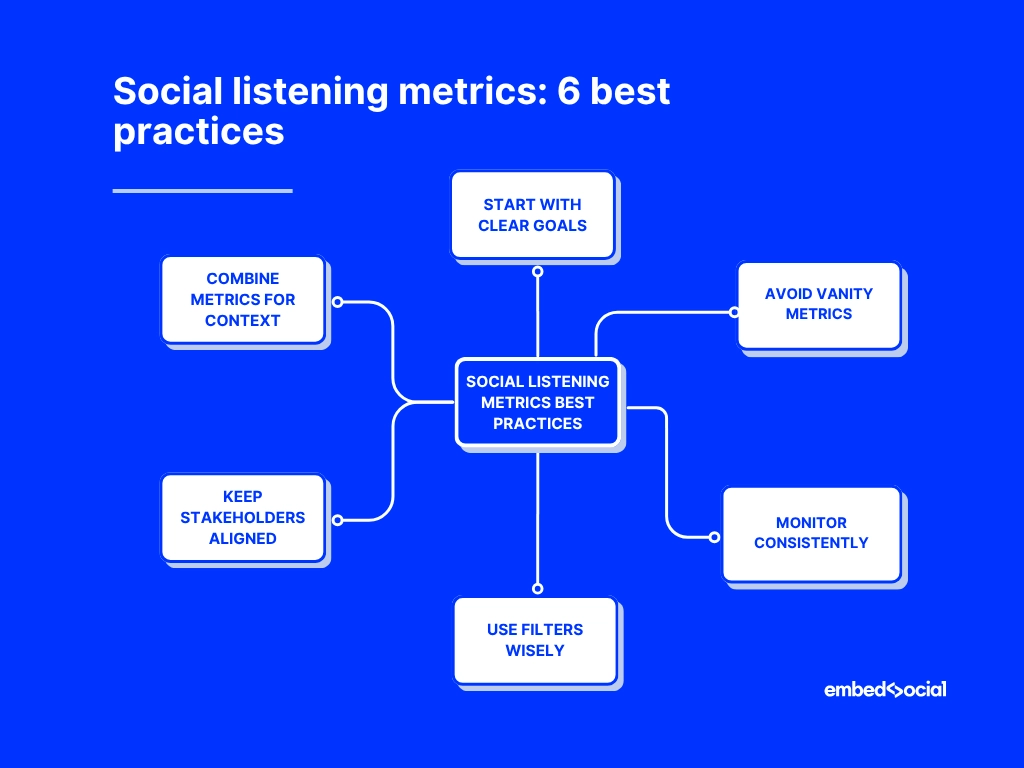
- Commencer par des objectifs clairs - définir ce que vous essayez d'améliorer (sentiment d'appartenance à la marque(performances des campagnes, informations sur les concurrents) ;
- Éviter les indicateurs de vanité - se concentrer sur les informations qui mènent à l'action, et pas seulement sur les grands chiffres ;
- Contrôler de manière cohérente - vérifiez régulièrement vos tableaux de bord pour détecter les tendances avant qu'elles ne s'estompent ou ne s'aggravent ;
- Utiliser les filtres à bon escient - réduire votre vue par sentiment, sujet ou canal pour révéler plus rapidement des informations ciblées ;
- Maintenir l'alignement des parties prenantes - partager régulièrement les principaux rapports et tendances avec votre équipe ;
- Combiner les mesures pour créer un contexte - examiner ensemble le sentiment, le volume et l'activité des influenceurs pour obtenir des résultats plus riches. analyse des sentiments dans les médias sociaux.
En suivant ces habitudes, vos mesures d'écoute sociale vous aideront à prendre les devants !
Conclusion : Commencez à suivre les indicateurs sociaux qui font progresser votre marque !
L'écoute sociale est une fenêtre sur ce que pense et ressent réellement votre public.
Après tout, lorsque vous suivez les bons indicateurs sur les bons canaux de médias sociaux, vous repérez les opportunités, prévenez les crises et gardez une longueur d'avance sur la concurrence.
Si vous optez pour l'un des meilleurs outils d'écoute sociale, vous obtiendrez toutes les informations dont vous avez besoin, des mentions au sentiment, que vous pourrez utiliser pour informer votre stratégie en matière de médias sociaux.
Commencez donc à suivre ce qui compte et transformez ces mesures en actions ! Il n'y a pas de moyen plus sûr d'assurer la satisfaction des clients et d'obtenir des informations sur le social listening.
Prêt à transformer les conversations en stratégie ?
👉 Commencez votre essai gratuit avec EmbedSocial et voyez les indicateurs sociaux de votre marque prendre vie - pas de problème d'installation, juste des informations instantanées.
FAQ sur les mesures d'écoute sociale
Comment mesurer l'écoute sociale ?
Vous mesurez l'écoute sociale en suivant des indicateurs clés tels que les mentions de la marque, le sentiment des clients, les sujets en vogue et l'activité des influenceurs sur plusieurs plateformes.
Quelles sont les mesures d'écoute sociale généralement incluses ?
Ils comprennent généralement le volume de mentions, la répartition des sentiments, la part de voix, les principales sources, les hashtags en vogue et l'engagement avec des messages ou des mots-clés spécifiques sur les médias sociaux.
À quelle fréquence dois-je examiner mes données d'écoute sociale ?
Les bilans hebdomadaires sont idéaux pour repérer rapidement les tendances, mais les marques à fort volume peuvent bénéficier de bilans quotidiens, en particulier pendant les campagnes de marketing ou les lancements.
Puis-je suivre mes concurrents à l'aide d'outils d'écoute sociale ?
Oui ! Des outils comme EmbedSocial vous permettent de surveiller les mentions, les hashtags et le sentiment des concurrents afin de pouvoir comparer les performances et repérer les opportunités du marché.
Comment mettre en place la bonne stratégie d'écoute sociale ?
Définissez des objectifs clairs, choisissez un outil fiable comme EmbedSocial, définissez des mots-clés et des filtres pertinents, suivez les indicateurs de base et analysez régulièrement les résultats pour éclairer vos décisions.
